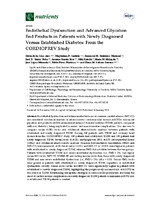Mostrar el registro sencillo del ítem
Endothelial Dysfunction and Advanced Glycation End Products in Patients with Newly Diagnosed Versus Established Diabetes: From the CORDIOPREV Study
| dc.contributor.author | Cruz‐Ares, Silvia de la | |
| dc.contributor.author | Cardelo, Magdalena P. | |
| dc.contributor.author | Gutiérrez Mariscal, Francisco Miguel | |
| dc.contributor.author | Torres‑Peña, J.D. | |
| dc.contributor.author | García-Ríos, Antonio | |
| dc.contributor.author | Katsiki, Niki | |
| dc.contributor.author | Malagón, María M. | |
| dc.contributor.author | López-Miranda, José | |
| dc.contributor.author | Pérez-Martínez, Pablo | |
| dc.contributor.author | Yubero-Serrano, Elena M. | |
| dc.date.accessioned | 2020-01-21T13:18:48Z | |
| dc.date.available | 2020-01-21T13:18:48Z | |
| dc.date.issued | 2020 | |
| dc.identifier.uri | http://hdl.handle.net/10396/19343 | |
| dc.description.abstract | Endothelial dysfunction and intima-media thickness of common carotid arteries (IMT-CC) are considered subclinical markers of atherosclerotic cardiovascular disease (ASCVD). Advanced glycation end products (AGEs) are increased in type 2 diabetes mellitus (T2DM) patients, compared with non-diabetics, being implicated in micro- and macrovascular complications. Our aim was to compare serum AGEs levels and subclinical atherosclerotic markers between patients with established and newly diagnosed T2DM. Among 540 patients with T2DM and coronary heart disease from the CORDIOPREV study, 350 patients had established T2DM and 190 patients had newly diagnosed T2DM. Serum levels of AGEs (methylglyoxal (MG) and N-carboxymethyl lysine (CML)) and subclinical atherosclerotic markers (brachial flow-mediated vasodilation (FMD) and IMT-CC) were measured. AGEs levels (all p < 0.001) and IMT-CC (p = 0.025) were higher in patients with established vs. newly diagnosed T2DM, whereas FMD did not differ between the two groups. Patients with established T2DM and severe endothelial dysfunction (i.e., FMD < 2%) had higher serum MG levels, IMT-CC, HOMA-IR and fasting insulin levels than those with newly diagnosed T2DM and non-severe endothelial dysfunction (i.e., FMD ≥ 2%) (all p < 0.05). Serum CML levels were greater in patients with established vs. newly diagnosed T2DM, regardless of endothelial dysfunction severity. Serum AGEs levels and IMT-CC were significantly higher in patients with established vs. newly diagnosed T2DM, highlighting the progressively increased risk of ASCVD in the course of T2DM. Establishing therapeutic strategies to reduce AGEs production and delay the onset of cardiovascular complications in newly diagnosed T2DM patients or minimize ASCVD risk in established T2DM patients is needed. | es_ES |
| dc.format.mimetype | application/pdf | es_ES |
| dc.language.iso | eng | es_ES |
| dc.publisher | MDPI | es_ES |
| dc.rights | https://creativecommons.org/licenses/by/4.0/ | es_ES |
| dc.source | Nutrients 12(1), 238 (2020) | es_ES |
| dc.subject | CORDIOPREV | es_ES |
| dc.subject | Type 2 diabetes mellitus | es_ES |
| dc.subject | Endothelial dysfunction | es_ES |
| dc.subject | Advanced glycation end products | es_ES |
| dc.subject | Methylglyoxal | es_ES |
| dc.subject | N‐carboxymethyl lysine | es_ES |
| dc.subject | Flow‐mediated vasodilation | es_ES |
| dc.subject | Intima‐media thickness of common carotid arteries | es_ES |
| dc.title | Endothelial Dysfunction and Advanced Glycation End Products in Patients with Newly Diagnosed Versus Established Diabetes: From the CORDIOPREV Study | es_ES |
| dc.type | info:eu-repo/semantics/article | es_ES |
| dc.relation.publisherversion | http://dx.doi.org/10.3390/nu12010238 | es_ES |
| dc.relation.projectID | Junta de Andalucía. PI‐0283/2017 | es_ES |
| dc.relation.projectID | Instituto de Salud Carlos III. FIS PI18/01822 | es_ES |
| dc.rights.accessRights | info:eu-repo/semantics/openAccess | es_ES |

